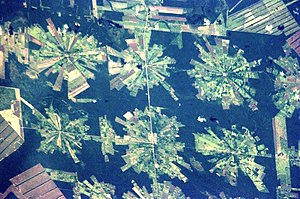Deforestation

Deforestation, clearance, clearcutting or clearing is the removal of a forest or stand of trees from land which is then converted to a non-forest use. Deforestation can involve conversion of forest land to farms, ranches, or urban use. The most concentrated deforestation occurs in tropical rainforests. About 31% of Earth's land surface is covered by forests. Between 15 - 18 million hectares of forest, an area the size of Belgium are destroyed every year, on average 2,400 trees are cut down each minute.
The Food and Agriculture Organization of the United Nations defines deforestation as the conversion of forest to other land uses (regardless of whether it is human-induced). “Deforestation” and “forest area net change” are not the same: the latter is the sum of all forest losses (deforestation) and all forest gains (forest expansion) in a given period. Net change, therefore, can be positive or negative, depending on whether gains exceed losses, or vice versa.
Agricultural expansion continues to be the main driver of deforestation and forest fragmentation and the associated loss of forest biodiversity. Large-scale commercial agriculture (primarily cattle ranching and cultivation of soya bean and oil palm) accounted for 40 percent of tropical deforestation between 2000 and 2010, and local subsistence agriculture for another 33 percent. Trees are cut down for use as building material, timber or sold as fuel (sometimes in the form of charcoal or timber), while cleared land is used as pasture for livestock and agricultural crops. The vast majority of agricultural activity resulting in deforestation is subsidized by government tax revenue. Disregard of ascribed value, lax forest management, and deficient environmental laws are some of the factors that lead to large-scale deforestation. Deforestation in many countries—both naturally occurring and human-induced—is an ongoing issue. Between 2000 and 2012, 2.3 million square kilometres (890,000 sq mi) of forests around the world were cut down. Deforestation and forest degradation continue to take place at alarming rates, which contributes significantly to the ongoing loss of biodiversity. The removal of trees without sufficient reforestation has resulted in habitat damage, biodiversity loss, and aridity. Deforestation causes extinction, changes to climatic conditions, desertification, and displacement of populations, as observed by current conditions and in the past through the fossil record. Deforestation also has adverse impacts on biosequestration of atmospheric carbon dioxide, increasing negative feedback cycles contributing to global warming. Global warming also puts increased pressure on communities who seek food security by clearing forests for agricultural use and reducing arable land more generally. Deforested regions typically incur significant other environmental effects such as adverse soil erosion and degradation into wasteland.
The resilience of human food systems and their capacity to adapt to future change depends on that very biodiversity – including dryland-adapted shrub and tree species that help combat desertification, forest-dwelling insects, bats and bird species that pollinate crops, trees with extensive root systems in mountain ecosystems that prevent soil erosion, and mangrove species that provide resilience against flooding in coastal areas. With climate change exacerbating the risks to food systems, the role of forests in capturing and storing carbon and mitigating climate change is of ever-increasing importance for the agricultural sector.
According to a study published in Scientific Reports if deforestation continue in current rate in the next 20 – 40 years, it can trigger a full or almost full extinction of humanity. To avoid it humanity should pass from a civilization dominated by the economy to "cultural society" that "privileges the interest of the ecosystem above the individual interest of its components, but eventually in accordance with the overall communal interest"
Deforestation is more extreme in tropical and subtropical forests in emerging economies. More than half of all plant and land animal species in the world live in tropical forests. As a result of deforestation, only 6.2 million square kilometres (2.4 million square miles) remain of the original 16 million square kilometres (6 million square miles) of tropical rainforest that formerly covered the Earth. An area the size of a football pitch is cleared from the Amazon rainforest every minute, with 136 million acres (55 million hectares) of rainforest cleared for animal agriculture overall. More than 3.6 million hectares of virgin tropical forest was lost in 2018. Consumption and production of beef is the primary driver of deforestation in the Amazon, with around 80% of all converted land being used to rear cattle. 91% of Amazon land deforested since 1970 has been converted to cattle ranching. The global annual net loss of trees is estimated to be approximately 10 billion. According to the Global Forest Resources Assessment 2020 the global average annual deforested land in the 2015–2020 demi-decade was 10 million hectares and the average annual forest area net loss in the 2000–2010 decade was 4.7 million hectares. The world has lost 178 million ha of forest since 1990, which is an area about the size of Libya.
Comments
Post a Comment